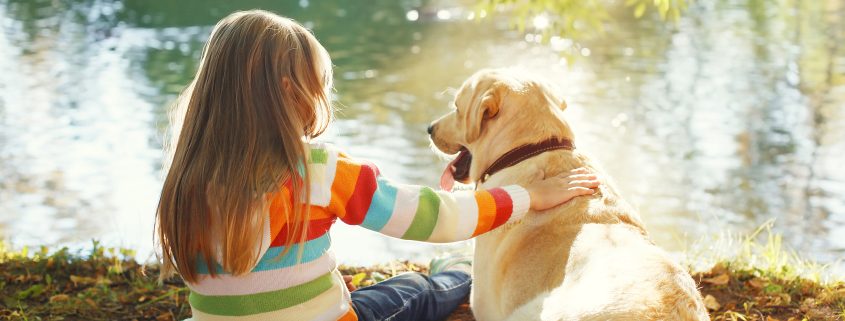There’s nothing sweeter than a child and a dog who are best friends. But as magical as that relationship may be, it doesn’t come naturally. Dogs can misbehave around kids if boundaries aren’t set and correct behaviors aren’t taught. It’s important to use positive reinforcement to train your dog how to behave around children. And you need to teach the children, too. Only when both parties understand one another can they build a strong bond. In this article, we cover crucial steps you can take to teach your dog how to behave when around children.
Start with Socialization
Puppies go through a critical period of development between the ages of about 8 and 16 weeks. They are more likely to learn to accept and be comfortable with a variety of people and situations if they are exposed to them during this time. If you have a new puppy, introduce it to children in a positive way. Make sure it meets children of various ages in a variety of situations. The children should be well-behaved and gentle with the dog.
If you have an adult dog, you can still work on socialization around kids. The process is similar to socializing a new puppy, it just has to happen much more slowly. During the process, make sure to offer plenty of valuable treats and praise, but remove your dog from the situation at the first sign of stress.
Practice Handling Exercises
Even the most well-behaved child sometimes can’t keep themselves from throwing their arms around a dog’s neck or tugging on a dog’s tail or ears. Prepare your dog for these kinds of situations before it is around a child. Give it lots of praise and maybe even a few treats while you gently play with its tail, hold its paws, hug it, and check out its ears. If your dog exhibits fear or anxiety at this gentle prodding, then it may be best to keep children at a distance.
Don’t Allow Your Dog to Jump Up
You may not mind your dog jumping up on you to say hello, but not everyone who meets your dog will feel the same way. It can be especially dangerous when introducing your dog to a young child who can be injured if your dog knocks them over.
Your best bet is to not allow your dog to jump up at all and train them to respect boundaries. If your dog jumps up when you walk through the door, you can either tell them no and push them down OR completely ignore them until they have settled. Once they realize you will only give attention and praise for not jumping up, they will learn to keep all four paws on the floor.
Introduce Dogs to Children’s Toys
Think about all the things children’s toys can do. Dolls and stuffed animals are often silent, but battery-operated toys make high-pitched noises and sometimes even play loud music, and sometimes they move unexpectedly. Balls get tossed or kicked across yards, and bikes and scooters whizz by quickly. All these things can tempt your dog to steal, chew, or chase them. While this can lead to toys being destroyed, it can also lead to children getting nipped or knocked over. On the other hand, sensitive dogs may be afraid of these toys and then start to associate that fear with children as well.
Introduce your dog to these toys without kids around first. This is when commands such as “leave it” and “stay” come in handy. Use these commands to keep your dog from stealing or chasing after toys and redirect your dog to appropriate dog-friendly toys–and don’t forget to reward with treats too!
Desensitize to Kid Noises and Habits
Let’s face it: kids behave differently than adults. They run around, yell, and move suddenly. To desensitize your dog to these habits, you can work on training them at a nearby park or playground. During that time you can keep your distance, and slowly work your way closer to commotion as your dog grows comfortable. If your dog seems anxious or fearful at any point, move further away and restart the process.
Crate Train Your Dog
Dogs often do better around children if they have a safe space to retreat to. Training your dog to go into their crate when they feel uncomfortable is crucial. Make it clear to any children in your home that the crate is off-limits to them. This way your dog can interact with the children when it wants to, but it also has a safe place to take a break.
Don’t Force Your Dog to Accept Children
Some people think holding a dog so a child can pet it is a good way to introduce them–not true! If a dog is afraid of children, holding it while a child approaches can be a terrifying experience that may cause the dog to react out of fear and growl, scratch, or nip. Instead, place your dog on the floor with its leash attached, allow the dog as much time as they need to get comfortable, and let the dog approach the child when ready to interact.
Keep Everything Positive
The best way to build a good relationship between your dog and children is to use positive reinforcement. When your dog is behaving well around children, be sure to give it lots of praise, treats, and attention. Your dog will learn that good things happen whenever kids are around. Soon your pup will be happily seeking out children and staying on its best behavior.
Your Pets are our Priority!
At the National Animal Supplement Council (NASC), our number one priority is to promote the health and well-being of your pets. That is why we created the NASC Audit Program and the Quality Seal, which helps you identify animal health and nutritional supplements from responsible suppliers committed to producing the highest quality, most consistent products. Visit our website to learn more and to see a list of NASC members who have earned the Quality Seal.


